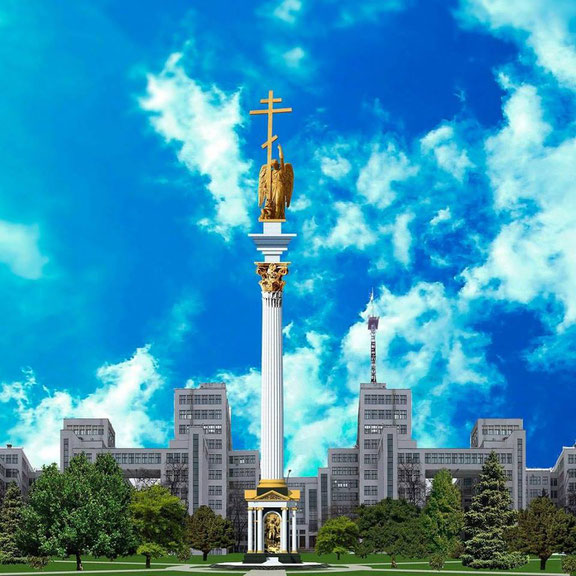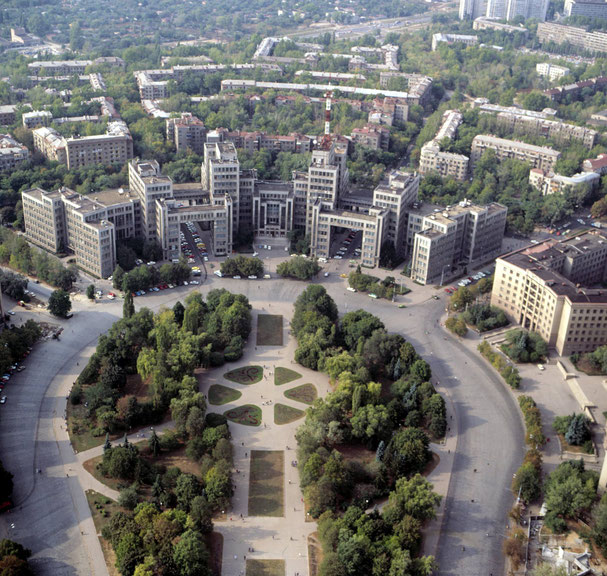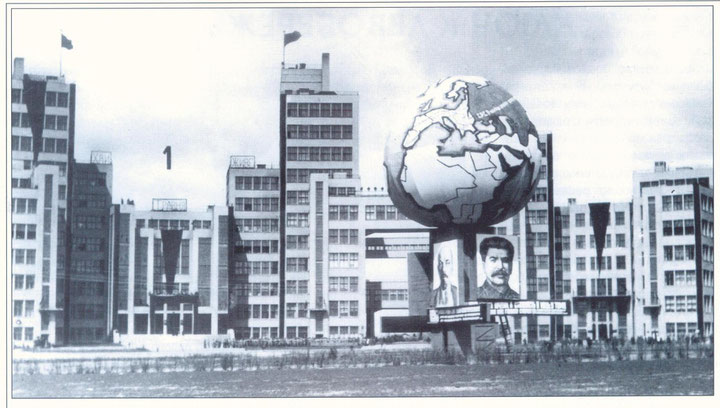Issue 3/2017 - Das Imperium schlägt zurück?
Discrimination against the Soviet Modernist Built Legacy in Kharkiv
In recent decades, the Soviet legacy has been an extremely popular subject among intellectuals and a wider audience around the world. We are regularly informed of numerous academic research projects, articles in the popular press, exhibitions, and conferences dealing with Soviet modernism. The attractive generalization “Soviet” has been vigorously objectified and exploited; it has sold well, especially in the export market. Even as the virtual success of this subject has emerged, the Soviet legacy itself has not merely been neglected, but has been robustly destroyed, which leads one to think there is a serious ethical crisis in how the Soviet legacy has been regarded.
Turned into a simple label, the generalized term “Soviet legacy” prevents us from seeing the phenomenon’s breadth and contradictions, from understanding how it functioned previously and how it functions today. Like the Soviet era itself, its legacy is not homogeneous. Different periods pursued different goals and ideologies. Sometimes, one Soviet period cannibalized or denied another Soviet period, while at other times they merged or became their own opposites. Sometimes, they feigned to be something they really were not. It is naïve to believe this large-scale, complicated phenomenon could be reduced to a simple tourist postcard. When we delve into it, however, we find great historical events, political processes, colossal tragedies, and people’s lives.
We shall try and evince empathy as we examine the destruction of Soviet modernism in Kharkiv in a broad context. What are the cause-effect relationships of the intensified war against the Soviet modernist legacy in recent decades and that legacy’s own struggle with itself?
Kharkiv and the Current Circumstances with the Modernist Legacy
As the capital of the Ukrainian Soviet Socialist Republic from 1919 to 1934, Kharkiv is often called the capital of Ukrainian constructivism. As such, it has had a quite dramatic history that has not been articulated. The city was rapidly developed during several waves of modernization. Kharkiv’s identity was shaped by modernity, the myth of the capital city, scientific and technological progress, and highly developed industries. Predictably, the outcome was an identity that was proletarian and grounded in the tangible and intangible Soviet legacy or, rather, the leftist legacy. Since Ukraine has gained independence, Kharkiv has faced many problems caused by socioeconomic crises, economic transformation, the shuttering of numerous factories, the wholesale, opaque privatization of public property, and the protracted, spasmodic transition to a postindustrial society.
In the west, there is the opinion that the destruction of the Soviet modernist heritage kicked off after Maidan in conjunction with the so-called Leninopad (i.e., the demolition of dozens of monuments to Lenin all over Ukraine) and the adoption of the controversial law on decommunization. This does not entirely reflect the real circumstances. For a long time, various players in Ukraine have for different reasons demolished sites reflecting the modernization processes of past eras. Thus, the Kharkiv mayor’s office had begun systematically destroying modernist sites well before Maidan happened. The sites it went after can be divided into large urban sites whose spatial organization and complexity have been ruined; sites of the same type, such as industrial facilities and sites embodying proletarian culture and everyday life, such as factory kitchens, clubhouses, and communes; and sites typical of certain styles and eras, such as Soviet constructivism, interwar modernism or Soviet postwar modernism.
Even as I write this, the town-planning integrity and individual buildings of the most vivid, radical exemplar of leftist urbanism, the socialist city (sotsgorod) New Kharkiv, a suburb of Kharkiv built for workers at the Kharkiv Tractor Plant between 1929 and 1934, are threatened with destruction. With the fraudulent permission of city authorities, the construction company Zhilstroy One has been redeveloping the green belt of the town’s original so-called functional flow zoning with ugly high-rises.
The most vulnerable legacy in Ukraine is that of postwar modernism: most of these buildings have not been placed on any heritage listings whatsoever. In April 2017, the Kharkiv City Council announced its intention to rebuild the Ukraina Cinema and Concert Hall, one of the first buildings in the country with a steel cable roof, and one of the best-known modernist buildings in Kharkiv, erected in 1963. The contract has been awarded to AROF, a company affiliated with the city’s chief architect. AROF has been mired in corruption, has a bad reputation, and has damaged a long list of heritage sites.
The apotheosis of this anti-modernist crusade was an attempt, in late 2016, by city officials to install a gigantic, 86-meter-high pillar, topped with an angel bearing an Orthodox Cross, on Freedom Square, directly opposite the world-famous Gosprom building. The pillar was designed by city official and chief architect Sergei Chechelnitsky and his brother. Built in 1929, the Gosprom building is an iconic structure to connoisseurs of modernism the world over, and is seen and recognized as the city’s symbol by Kharkiv’s residents. This possible precedent angered them, provoking a huge response in Ukrainian media, protest rallies, and a broad public discussion of the need for historic preservation. Local civil society was not going to put up with the project and sued the Kharkiv City Council. Despite the thoroughgoing corruption in the Ukrainian judiciary, the entire Kharkiv community was greeted with a truly unique piece of news. Nearly for the first time, the Kharkiv City Council lost its case in court: the decision to build the column was declared illegal. It was a real triumph. As of today, it is the only precedent for preserving the modernist built heritage in Ukraine, but it has been a very important precedent.
Factors and Actors in the Discrimination against Soviet Modernist Built Heritage
To answer the question of why it has been so important, I would try and identify the main factors and actors that have specifically impacted the destruction of the modernist heritage, in particular, Freedom Square, the Ukraina Cinema and Concert Hall, and New Kharkiv. If we start by listing Ukraine’s problems, it would be worth mentioning savage capitalism, high levels of corruption, weak laws, and an unstable law enforcement and judicial system. Demodernization per se, typical of the entire post-Soviet realm, has been superimposed on all this. In addition, the international phenomenon of postmodernism has been an important precondition for the events I describe here.
Demodernization is a term used by historians to denote a process that has not been sufficiently researched, and yet it aptly describes everything that has happened in the former Soviet Union since 1991. At one time, the Soviet Union, which included Ukraine, was one of the most striking examples of the impact made on a country by several hard, rapid waves of accelerated, total modernization, which has left behind a considerable tangible legacy, difficult to ignore. Thus, rapid demodernization has occurred in the post-Soviet space, and in some cases this legacy has been targeted for enrichment, redistribution, and barbaric destruction.
Postmodernism has been another factor. We underestimate its power due to its superficial chaos, gaiety, playfulness, etc. But the power of chaos is much stronger than the power of construction: it is hybrid and mercurial. We still do not know what motivates it, its objectives, and how it operates. It would be a big mistake to ignore those who profit from it.
Historically speaking, such factors include Stalinism, namely, the Stalinist policy of appropriation vis-à-vis the modernist heritage. In the early 1930s, Stalin’s fundamental turn in cultural policy, involving the return to so-called classical canons and traditionalism, set off a campaign of persecution against constructivism, which came to be seen as an inimical tendency that had surrendered to bourgeois, cosmopolitan influences. In the late 1930s, architects not only sought a new architectural idiom but also redeveloped projects previously implemented in the constructivist style to conform with the new taste for neoclassicism. After the Second World War, we witness the large-scale reconstruction of constructivist buildings, involving neoclassical details, luxurious ornamentation, and ceramic and stone cladding. History was thus falsified, and the NEP period, the last period before the onset of the Stalinist dictatorship, was appropriated. Kharkiv’s Freedom Square is a vivid example of this mode of appropriation, a Stalinist construct as narrated by architects.
Interest has also been provoked by the Russian imperial construct, which was embedded for many years by officials and institutions of power. The so-called Russian world [Russkii mir], i.e., the reconstruction of the Russian Empire, reflects the current policies of the Russian Federation. It was implanted in Ukraine from 2003 to 2004 along with the country’s so-called Moscow-directed development vector, as set down in the waning days of Leonid Kuchma’s administration and especially under Viktor Yanukovych. It enjoyed a fair amount of support in Kharkiv. The Russian imperial construct is a hybrid, accommodating glorification of the Stalinist period and enforced religiosity. Modernism is thus stylistically and methodologically opposed to the program outlined by adherents of the “imperial” Kharkiv myth. Therefore, constructivist buildings have been redecorated and rebuilt, and their milieu has been saturated with elements executed in a pseudo-classical style that imitates historical buildings from the times of the Russian Empire. In this case, a special role has been played by the unprecedented number of religious buildings built by the Russian Orthodox Church on public lands allocated to the church by city authorities.
The Ukrainian Institute of National Remembrance (UNIR), a state institution representing the central government, has played an equally important role in this conflict. It is invested with decision-making powers and can approve legislation affirming the new policy of remembrance. It does not destroy the built legacy itself, but all its work involves stigmatizing and generalizing the entire Soviet heritage. The acme of the UNIR’s activities has been the law on decommunization, which has resulted in the destruction of thousands of mosaics, bas-reliefs, sculptures, and monumental paintings imbued with communist symbols.
Ukrainian historical preservation laws are filled with loopholes, leading to corruption and the destruction of landmarks. The bodies involved in historical preservation are organized in such a way that they embody conflicting interests and bear no real responsibility for their actions. There is thus no incentive for state agencies to deal with historical preservation. The Ukrainian offices of ICOMOS and Docomomo have advisory status, but in practice they are counterfeits and have only aided developers and authorities in legitimizing decisions that damage heritage sites. They are mostly interested in ancient archaeological excavations and wooden churches, not in twentieth-century architecture.
Given this set of conditions and factors, as well as the actions taken by actors, the outcome has been a series of deep protracted conflicts, a war among different centuries and narratives, and a crisis of memory and identity in Ukraine as a whole and Kharkiv in particular. Amid the chaos and in the absence of a strategy for overcoming the crisis, especially in the current circumstances, architecture and the cityscape, just as a hundred years ago and two hundred years ago, reflect the political conjuncture in Ukraine even more than the societal conjuncture. In turn, civil society has been interested in solving issues related to collective memory and fighting to protect the historical legacy. Society has come to take responsibility for the past and the present, things that definitely do not interest the regime.
Discrimination against Modernism as a Global Phenomenon
Kharkiv’s Freedom Square, a unique place, worthy of world fame, is only a particular case in an international trend. This is not an act of violence against a specific square or site, but only one example of discrimination against modernism in the world. Of course, there is a temptation to simplify things and say that Ukraine is inhabited by savages who destroy their own cultural heritage. But then the same savages must have settled in London and Stuttgart.
Attacks on modernism have been carried out all over the world. So, in London there was a big scandal over plans to redevelop the Robin Hood Gardens housing estate; in Oslo, over plans to demolish the Y-building, which contains frescoes by Picasso; in Stockholm, over the reconstruction of the Stockholm Public Library; in Stuttgart, over demolition of Stuttgart Central Station; in Chicago, over demolition of the Prentice Women’s Hospital Building; and in New York, over plans to demolish and redevelop the Worldport Terminal at JFK Airport. All these controversies caused extensive grassroots historical preservation campaigns, media coverage, protest rallies, and condemnation by experts.
Before our eyes, discrimination and violence against the modernist built heritage has taken on a colossal scale. It has become inevitable and total. A wider study shows that the destruction of architectural modernism and all traces of modernization has been systemic. It is not something unique to Ukraine, but a global phenomenon. Defining it and understanding what it is and why it is happening matter in order that we sound the alarm today and shift our efforts to historical preservation campaigns and defensive strategies. Overnight, modernist architecture has gone from its previous position of dominance. It has become a marginalized and vulnerable group of sites and buildings that are being forcibly deleted from physical space and our history.
Wars of Civilization, Memory, and Heritage
If we take a broader look at modernism, the international modernization project shared a number of traits with colonialism. Like the old empires in terms of their actions, trends, cause-effect relations, and political objectives, the empire of modernity had a civilizing mission. It seized lands, not legal or physically, but by spreading modernism, its culture, its values, and even its canons and rules. The project was supranational, not attached to particular places. What was its mission? Colonization by means of progress?
By analogy with ancient civilizations, which succeeded one another and destroyed the legacy of their predecessors, we are now witnessing the erasure of modernism’s sites. Worrying questions inevitably arise. What power is this, what new civilization, which is trying to destroy the memory of the past? Along with modernism’s physical legacy and intellectual heritage, does it want to destroy the values of modernity, progress, and humanism, including the notion of the world order established after the Second World War? For a war against material heritage is never a war with the material world per se. We should have a look at the other side of the process, where Trump, Putin, the right-wing traditionalist governments of Eastern Europe, and Brexit hold sway. Is it a war between modernism and postmodernism, a war between crises and economic models, a war among classes? Or is it a civilizational war over values?
On the other hand, we also need to think about why the landmarks of a vanishing modernist civilization are destroyed. Perhaps because modernism embodies values that are no longer relevant to man. Perhaps people no longer want progress? Maybe the word is a relic of the twentieth century, and nowadays regress or something else is popular? Or, maybe, the notion of progress has changed, and modernism has ceased to embody its values? Like missionary projects, the waves of modernism in the twenties and the sixties were responses to humankind’s global crises. They provided answers to yesterday’s questions and have often had nothing to say about today’s new crises. Consequently, they have become a permanent and convenient target of criticism.
Fortunately or unfortunately, I think that circumstances have now ripened for updating modernism. Those who espouse its values and defend it should finally come out of the shadows—not to use the techniques and methods of twentieth-century modernism, but to seek out a new, twenty-first century modernism. They will have to try and save the world right at a time when postmodernism and anti-globalist approaches have been overwhelmed. Now is the moment when we must stop being embarrassed of ourselves, take responsibility, and try and answer the tough questions. If the answers are not supplied by nominal modernists, they will be supplied, say, by someone of Donald Trump’s ilk. No one knows who will benefit from his answers.
The conflict in Kharkiv’s Freedom Square and civil society’s victory give hope that an irate modernism has every reason to awaken. And yet, I would like to caution against objectifying the modernist legacy and modernism in general while forgetting its subjectivity. The Gosprom building is much more precious to the Kharkiv community than pseudo-antiquities and kitsch, and modernism’s values still force people to take to the streets. Gosprom has won the battle, even though it stubbornly gives the answer, rather than asking the question about the difference between construction and deconstruction. It is not the ruins of a bygone civilization, but a player in life even today. Its ideas are not just amusing nor are its sites and buildings merely good backdrops for holiday album snapshots. Modernist civilization has not vanished, because it is a supracivilization that continues on its way to its destination. Strangely enough, in these parts, it is “more alive than all the living.”
The story of Freedom Square suggests society is weary of questions and the lack of boundaries. We are weary of slapping all the actors on the wrists, exposing their goals, and chasing them around. The time has come when we must agree on the rules of the game, because we are entering the pitch. Agreeing on rules and setting boundaries are, in fact, harbingers of modernism’s return. We must define our own boundaries and, perhaps, build a new construct, no matter how awkward it might sound. But, for starters, we must win the battle for modernism’s legacy, neither more nor less.
Translated by Thomas Campbell


